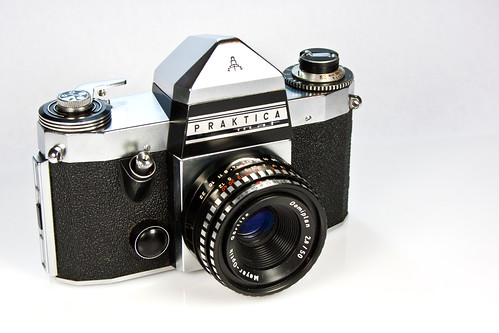Difference between revisions of "Praktica"
| Line 11: | Line 11: | ||
It became a long-lasting series of SLRs produced by [[KW]] and then by [[Pentacon]]. The last Praktica produced was the '''BX20s''', discontinued in 2001. | It became a long-lasting series of SLRs produced by [[KW]] and then by [[Pentacon]]. The last Praktica produced was the '''BX20s''', discontinued in 2001. | ||
| + | |||
| + | ==Overview== | ||
The first m42 camera is said to be the original "Praktica," which resembles the Praktiflex but has a redesigned body and viewfinder hood. Versions of the Praktica exist with no flash sync, multiple sets of vacublitz terminals, single PC socket, and/or special terminals recessed in a oval-shaped divot on the bottom of the camera. Some of these blur into later models with specific names, but all are labeled merely as "Praktica." | The first m42 camera is said to be the original "Praktica," which resembles the Praktiflex but has a redesigned body and viewfinder hood. Versions of the Praktica exist with no flash sync, multiple sets of vacublitz terminals, single PC socket, and/or special terminals recessed in a oval-shaped divot on the bottom of the camera. Some of these blur into later models with specific names, but all are labeled merely as "Praktica." | ||
| + | |||
| + | The early Prakticas are fairly typical of 50's SLR's, with a shutter bearing a resemblance to the original [[Leica]] focal-plane shutter: the shutter speed dial rotates in one direction when being cocked, then rotates quickly in the opposite direction when fired. Part of the dial is lifted up and turned relative to the whole to change the setting. Similar to other Leica-type shutters, though with an important distinction, a second timer must be engaged for slow speeds. The difference from, say, the [[Leica III]], is that this timer is engaged with a simple on-off switch, and its settings are on the same dial as the fast speeds. | ||
| + | |||
| + | The most consistent hallmark of the series would be the front-mounted shutter release. This placement originates in the Praktica's birth at a time when waist-level finders were standard on SLR's. Top-mounted shutter release would be less ergonomic when using the SLR at waist or chest height. There is a school of thought that the front-mounted shutter release allows a steadier grip and thus sharper handheld pictures. | ||
The subsequent named models in the first series of Prakticas all consistently have two types of sync: X, universally, and one of several kinds of flasbulb sync, whether M, F, or "F." which is a delay slightly longer than "F". PC sockets became standard during the lifetime of the FX model, which also exists in a Vacublitz model. | The subsequent named models in the first series of Prakticas all consistently have two types of sync: X, universally, and one of several kinds of flasbulb sync, whether M, F, or "F." which is a delay slightly longer than "F". PC sockets became standard during the lifetime of the FX model, which also exists in a Vacublitz model. | ||
| − | F.X2 redesigns the viewfinder hood, compromising its core functionality somewhat<ref>this finder hood is very short when raised and often requires being shielded with the hand in overhead light</ref> in exchange for being able to put a removable pentaprism much closer to the focusing screen. F.X3 adds a bumper for Contax/Pentax-style automatic lenses, actuated directly by the shutter release. Large fixed prisms were added in the next model, the "Praktica IV." More drastic redesigns followed. | + | F.X2 redesigns the viewfinder hood, compromising its core functionality somewhat<ref>this finder hood is very short when raised and often requires being shielded with the hand in overhead light</ref> in exchange for being able to put a removable pentaprism much closer to the focusing screen. F.X3 adds a bumper for Contax/Pentax-style automatic lenses, actuated directly by the shutter release. Large fixed prisms were added in the next model, the "Praktica IV." |
| + | |||
| + | More drastic redesigns followed. The IV B introduced a built-in meter, the Nova remodeled various aspects of the body, and subsequent models introduced more and more modern features, moving away from the now-archaic model of SLR that the first Praktica was an example of. The shutter release would be redesigned, while remaining on the front of the camera, the rotating dial would vanish (and not be lamented), and TTL metering would become standard. Eventually the line pioneered the metallized plastic covering that would become standard on Japanese SLR's in the 70's, though with the lag of technology in the Eastern Bloc, the line would never regain its former prestige or place as a high-end cutting-edge SLR. | ||
For other Praktica products, like compact cameras, 120 rollfilm cameras or digital products, please refer to the [[Pentacon]] pages. | For other Praktica products, like compact cameras, 120 rollfilm cameras or digital products, please refer to the [[Pentacon]] pages. | ||
Revision as of 17:40, 14 August 2021

|
| image by bottledog (Image rights) |
Praktica started as the name of a model of 35mm SLR from KW, introduced in 1949 and successor to the Praktiflex.
It became a long-lasting series of SLRs produced by KW and then by Pentacon. The last Praktica produced was the BX20s, discontinued in 2001.
Overview
The first m42 camera is said to be the original "Praktica," which resembles the Praktiflex but has a redesigned body and viewfinder hood. Versions of the Praktica exist with no flash sync, multiple sets of vacublitz terminals, single PC socket, and/or special terminals recessed in a oval-shaped divot on the bottom of the camera. Some of these blur into later models with specific names, but all are labeled merely as "Praktica."
The early Prakticas are fairly typical of 50's SLR's, with a shutter bearing a resemblance to the original Leica focal-plane shutter: the shutter speed dial rotates in one direction when being cocked, then rotates quickly in the opposite direction when fired. Part of the dial is lifted up and turned relative to the whole to change the setting. Similar to other Leica-type shutters, though with an important distinction, a second timer must be engaged for slow speeds. The difference from, say, the Leica III, is that this timer is engaged with a simple on-off switch, and its settings are on the same dial as the fast speeds.
The most consistent hallmark of the series would be the front-mounted shutter release. This placement originates in the Praktica's birth at a time when waist-level finders were standard on SLR's. Top-mounted shutter release would be less ergonomic when using the SLR at waist or chest height. There is a school of thought that the front-mounted shutter release allows a steadier grip and thus sharper handheld pictures.
The subsequent named models in the first series of Prakticas all consistently have two types of sync: X, universally, and one of several kinds of flasbulb sync, whether M, F, or "F." which is a delay slightly longer than "F". PC sockets became standard during the lifetime of the FX model, which also exists in a Vacublitz model.
F.X2 redesigns the viewfinder hood, compromising its core functionality somewhat[1] in exchange for being able to put a removable pentaprism much closer to the focusing screen. F.X3 adds a bumper for Contax/Pentax-style automatic lenses, actuated directly by the shutter release. Large fixed prisms were added in the next model, the "Praktica IV."
More drastic redesigns followed. The IV B introduced a built-in meter, the Nova remodeled various aspects of the body, and subsequent models introduced more and more modern features, moving away from the now-archaic model of SLR that the first Praktica was an example of. The shutter release would be redesigned, while remaining on the front of the camera, the rotating dial would vanish (and not be lamented), and TTL metering would become standard. Eventually the line pioneered the metallized plastic covering that would become standard on Japanese SLR's in the 70's, though with the lag of technology in the Eastern Bloc, the line would never regain its former prestige or place as a high-end cutting-edge SLR.
For other Praktica products, like compact cameras, 120 rollfilm cameras or digital products, please refer to the Pentacon pages.

|

|
| Ilafot shop in Dresden 1984 | Dresden, Prague Street, in 1991 |
| images by Jim Cooper (Image rights) |
List of Praktica 35mm SLRs
Praktiflex
Praktica / MX / FX
- Praktica
- Praktica MX
- Praktica FX
- Praktica "Modell III" (FX2)
- Praktica F.X 2
- Praktica F.X 3
Praktica IV / V
- Praktica IV
- Praktica IV B
- Praktica IV M
- Praktica IV BM
- Praktica IV F
- Praktica IV FB
- Praktica V F
- Praktica V FB
Praktica nova
- Praktica nova
- Praktica nova B
- Praktica mat
- Pentaflex SL (=Porst reflex FX 3)
Praktica PL nova
- Praktica PL nova I (=Hanimex Praktica nova I)
- Praktica PL nova I B (=Pentor I B, Porst FX 4, Hanimex Praktica nova I B)
- Praktica PL electronic
- Praktica super TL (=Hanimex Praktica super TL, Porst reflex FX 6)
1st L-series generation
- Praktica L
- Praktica LLC
- Praktica LTL
- Praktica LB
- Praktica VLC
- Praktica LTL 2
- Praktica TL
- Praktica super TL 2
- Praktica Super TL 3
2nd L-series generation
- Praktica LTL 3
- Praktica PLC 2
- Praktica L2
- Praktica LB 2
- Praktica VLC 2
- Praktica EE 2
- Praktica DTL 2
3rd L-series generation
- Praktica super TL 3
- Praktica MTL 3 (=Revueflex TL 25, Revueflex TL I)
- Praktica PLC 3
- Praktica VLC 3
- Praktica DTL 3
- Praktica EE 3
4th L-series generation
- Praktica super TL 1000
- Praktica super TL 500
- Praktica MTL 5 (=Revue ML, Revueflex TL 25)
- Praktica MTL 5 B (=Revue ML)
- Praktica MTL 50
Praktica B-series
- Praktica B
- Praktica B 100
- Praktica B 200
- Praktica BC 1(=Jenaflex AM 1)
- Praktica BC 3
- Praktica BC auto
- Praktica BCA (=Jenaflex AC 1)
- Praktica BCC
- Praktica BCS
- Praktica BCX
- Praktica BM
- Praktica BMS (= Revue BC 2)
Praktica BX-series
- Praktica BX20
- Praktica BX 10 DX
- Praktica BX 21 DX
- Praktica BX20S
References
- ↑ this finder hood is very short when raised and often requires being shielded with the hand in overhead light
- ↑ image of Praktica FX 2 by Michele M. F. (Image rights)
- ↑ image of Praktica nova by bottledog (Image rights)
- ↑ image of Praktica PLC 3 by bottledog (Image rights)
- ↑ image of Praktica MTL 5 by Martin Taylor (Image rights)
- ↑ image of Praktica BCS by Uwe Kulick (Image rights)
Links
- praktica-collector.de, all about Praktica
- Praktica B Kameras, Praktica B series cameras, lenses and accessories
- Listing of most Praktica camera models user manuals in PDF format, from OrphanCameras.com
- normal Praktica variants in dresdner-kameras.de
- Some photos taken off with a Praktica MTL3
- Foto Krenkel's Praktica museum (German)
- Praktica Camera Manuals : Photo-Manuals.com
- Pentacon on www.collection-appareils.fr by Sylvain Halgand (in French)




